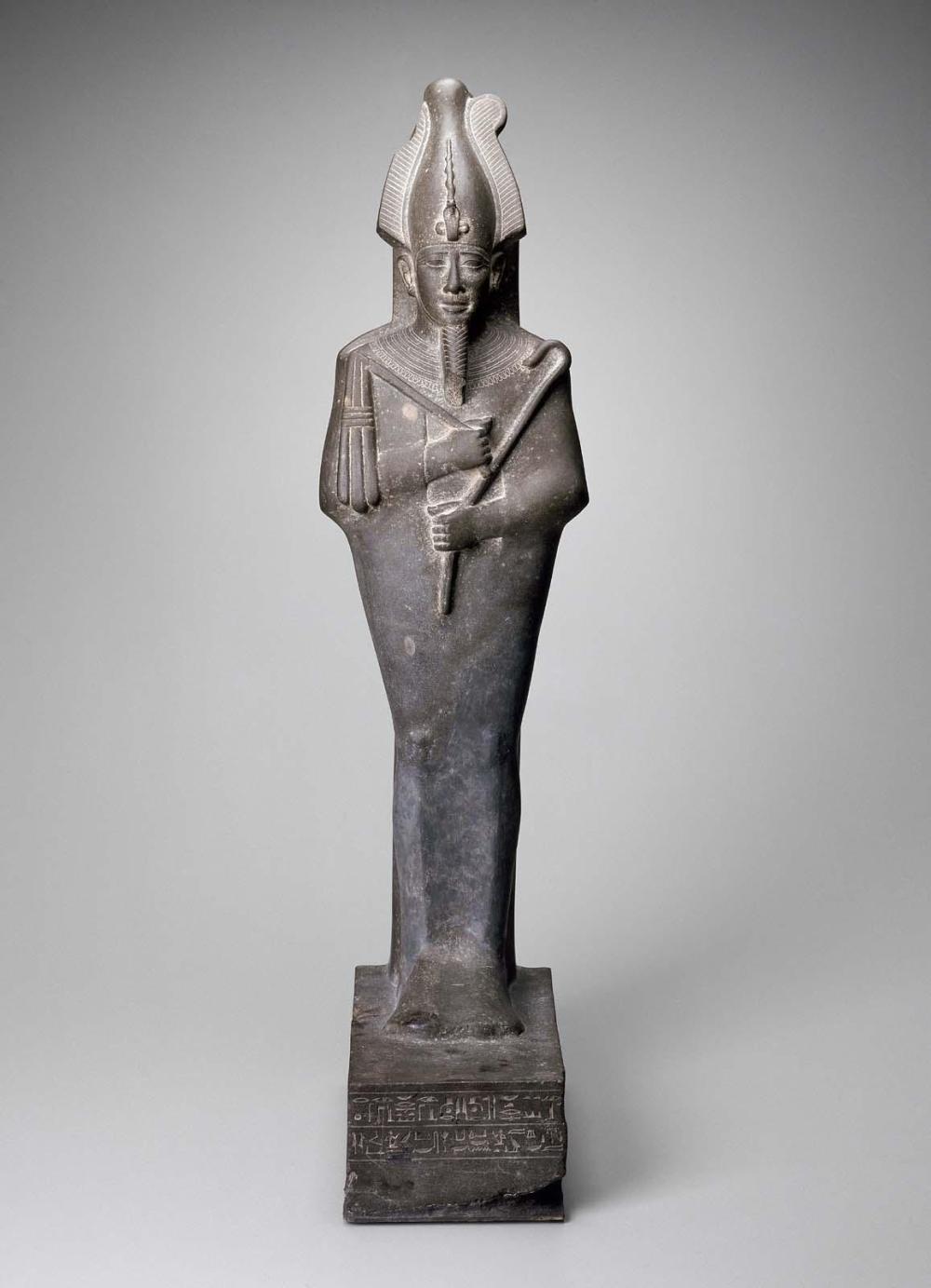Advanced Search 

Statue of Osiris (feet and base)
Egyptian
Late Period, Dynasty 26
664–525 B.C.
Findspot: Egypt, Giza
Medium/Technique
Greywacke
Dimensions
Height x width x depth: 20 x 15.5 x 29 cm (7 7/8 x 6 1/8 x 11 7/16 in.) - Lower Part
Height: .55cm (21 5/8 in) - upper part
Weight: 33.6 KG ( 74 LBS )
Height: .55cm (21 5/8 in) - upper part
Weight: 33.6 KG ( 74 LBS )
Credit Line
Museum purchase with funds donated by Stanford Calderwood in honor of Norma Jean Calderwood, a member of the Visiting Committee of Art of the Ancient World
Accession Number2000.973
CollectionsAncient Egypt, Nubia and the Near East
ClassificationsSculpture
DescriptionOsiris, god of the dead, stands mummiform, arms folded right over left, with wedge-formed feet. Head and hands emerge from a shroud so smoothly contoured to the shape of the body that details such as arms, elbows, and kneecaps emerge from the plain undifferentiated surface as islands of relief, while the crook and flail appear less as accessories than as organic outgrowths of the underlying form. The base and back pillar are inscribed with mortuary texts on behalf of the “king’s acquaintance” Ptahirdis, whose father’s name was Wepwawetem-
saf and whose mother’s name was Merptahites.
The statue has the oldest modern history in the Egyptian collection. The upper part (from the knees up) was excavated in 1928 by the Harvard University-Museum of Fine Arts Expedition in the shaft of Giza tomb 7792, east of the Great Pyramid. The lower part (base and ankles) was discovered 130 years earlier. It was brought to France by General Jean Lannes (later marshal of France and duke of Montebello), one of Napoleon’s most valiant officers, who participated in the short-lived but epoch-making Egyptian Campaign of 1798–1801, the beginning of the modern science of Egyptology.
General Lannes by all reports was no antiquarian. The feet of Osiris passed down in his family for six generations until 1999, when Egyptologist Olivier Perdu, visiting French country house collections of antiquities, recognized it as belonging to the MFA fragment. Although it does not directly join (approximately 8 centimeters [3 inches] in the middle are restored), its size, shape, material, and above all the identical names and titles of the personages mentioned in the inscriptions leave no doubt that it belongs. Through the generosity of a friend the lower part was purchased by the Museum, and the two fragments, sundered in antiquity, are now one. The result is both a masterpiece of Late Period sculpture and a historical link with the founding moment of modern Egyptology.
saf and whose mother’s name was Merptahites.
The statue has the oldest modern history in the Egyptian collection. The upper part (from the knees up) was excavated in 1928 by the Harvard University-Museum of Fine Arts Expedition in the shaft of Giza tomb 7792, east of the Great Pyramid. The lower part (base and ankles) was discovered 130 years earlier. It was brought to France by General Jean Lannes (later marshal of France and duke of Montebello), one of Napoleon’s most valiant officers, who participated in the short-lived but epoch-making Egyptian Campaign of 1798–1801, the beginning of the modern science of Egyptology.
General Lannes by all reports was no antiquarian. The feet of Osiris passed down in his family for six generations until 1999, when Egyptologist Olivier Perdu, visiting French country house collections of antiquities, recognized it as belonging to the MFA fragment. Although it does not directly join (approximately 8 centimeters [3 inches] in the middle are restored), its size, shape, material, and above all the identical names and titles of the personages mentioned in the inscriptions leave no doubt that it belongs. Through the generosity of a friend the lower part was purchased by the Museum, and the two fragments, sundered in antiquity, are now one. The result is both a masterpiece of Late Period sculpture and a historical link with the founding moment of modern Egyptology.
ProvenanceBetween 1798 and 1801, probably found at Giza, Egypt, and acquired by Pierre-Simon Gerard (b. 1765 - d. 1836) or Jean Lannes, 1st Duc de Montebello (b. 1769 - d. 1809) [see note 1]; taken to France and passed by descent within the family to France de Montebello de Baecque and her sister, Joelle Lannes de Montebello de Fraguier, Neuilly; 2000, sold by France de Montebello de Baecque and Joelle Lannes de Montebello de Fraguier to the MFA. (Accession Date: October 25, 2000)
NOTES:
[1] This is the base of a statue of Osiris (MFA accession no. 29.1131), which was excavated at Giza in 1928 by the Harvard University-Museum of Fine Arts Expedition. Though the early provenance of the base is not documented, Olivier Perdu, "L'Osiris de Ptahirdis reconstitué," Studien zur Altägyptischen Kultur 27 (1999): pp. 2-3 has proposed it was removed from Egypt by either Pierre-Simon Gerard or Jean Lannes de Montebello, from whom the sellers were descended. Both served in Napoleon’s Egyptian campaign of 1798-1801. Gerard was an engineer who is known to have stopped in Giza. General Lannes de Montebello was a military officer. The base was re-discovered in the 1990s at the family home at Château de Stors.
NOTES:
[1] This is the base of a statue of Osiris (MFA accession no. 29.1131), which was excavated at Giza in 1928 by the Harvard University-Museum of Fine Arts Expedition. Though the early provenance of the base is not documented, Olivier Perdu, "L'Osiris de Ptahirdis reconstitué," Studien zur Altägyptischen Kultur 27 (1999): pp. 2-3 has proposed it was removed from Egypt by either Pierre-Simon Gerard or Jean Lannes de Montebello, from whom the sellers were descended. Both served in Napoleon’s Egyptian campaign of 1798-1801. Gerard was an engineer who is known to have stopped in Giza. General Lannes de Montebello was a military officer. The base was re-discovered in the 1990s at the family home at Château de Stors.
